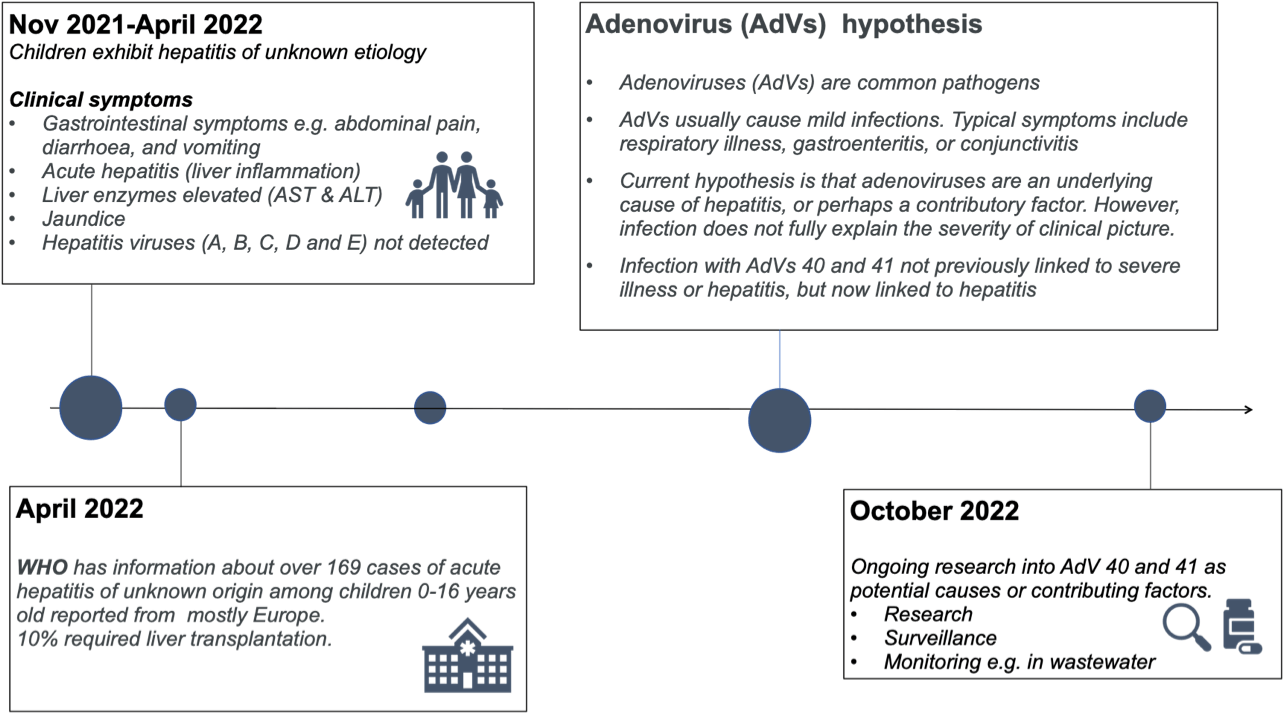Background
Hepatitis (severe liver inflammation) can result from pathogens, toxins, or autoimmune reactions. Most often, it is caused by the hepatitis A, B, D, or E viruses (hepatitis D is always found together with B). However, other viruses, such as the Epstein-Barr virus or Cytomegalovirus (CMV), may cause hepatitis in children.
Patients often exhibit a yellowish colouration in the skin and whites of the eye, as well as gastrointestinal symptoms, such as vomiting, diarrhea, and light faeces. In severe cases, it can ultimately lead to liver failure that requires dialysis or transplantation to treat. Hepatitis in children (<16 years) is not common, but cases can become acute. Today, between every second and third case of childhood hepatitis is of unknown origin, meaning that the cause is not identified, according to estimates from the Centre for Disease Control (CDC) (CDC, 2022). There has been an unusual increase in the number of cases of acute heptatitis of unknown etiology in children over the last year.
Outbreak in 2022
In April 2022, a number of cases of severe hepatitis of unknown origin were detected in children in the UK. These cases were subsequently reported to the WHO International Health Regulations system. The children had not tested positive for any of the most common viral hepatitis types A-E, nor any other known causes of hepatitis UK Health Security Agency, 2022. Since then, multiple countries, including the US, Japan, Ireland, Netherlands, Denmark, and Sweden, have reported similar increases in the number of pediatric patients with hepatitis of unknown origin (Folkhälsomyndigheten, 2022). Research into the possible causes and contributing factors, is still ongoing, as are monitoring efforts focussed on identifying cases.
The primary hypothesis, as of October 2022, is that the cases may be caused by human adenovirus (HAdV). In support of this, adenovirus was the most frequently detected potential pathogen in a matched case control study of 74 cases and 225 controls in the UK. However, not all pediatric patients with acute hepatitis of unknown etiology have tested positive for adenovirus. In the same study, researchers considered the possibility that there may be a connection to COVID-19, but found no evidence for this.
Adenoviruses are common viruses, with >100 types and seven species (A-G), capable of infecting both humans and animals. Usually, adenoviruses cause only mild symptoms in humans, although the types of symptoms differ, with some subtypes causing respiratory illnesses and others causing gastroenteritis, for example. Adenovirus type F41, which is currently under investigation by the CDC, is part of the latter group; typically causing diarrhea, abdominal pain, and vomiting over a relatively short period (1-2 weeks) in otherwise healthy children and adults. Rafie et al. (2021) recently identified the structural information about the HAdVs types F40 and F41. These two HAdVs are common causes of global diarrhea-associated death in young children.
The CDC is currently conducting research and working in close collaboration with health providers across the US to identify children with hepatitis of unknown origin (CDC, 2022). Today, many research groups are investigating possible causes for increased hepatitis of unknown etiology in children. In addition, there are multiple ongoing surveillance efforts including, for example, monitoring focussed on the detection on pathogens, including adenoviruses, in wastewater. A group in Sweden have recently developed new primer sets to detect recent human adenovirus F41 variants in wastewater to this end (Perez-Zabaleta et al., 2022). The Swedish COVID-19 and Pandemic Preparedness Portal hopes to add more content on adenoviruses in the near future.
Timeline of outbreak

Resources
-
Swedish Health Agency (Folkhälsomyndigheten): Suspected cases of hepatitis of unknown cause reported in Sweden
-
European Centre for Disease Prevention and Control (ECDC): Surveillance bulletin
-
World Health Organisation (WHO): Information about hepatitis outbreaks
-
National Health Service (NHS): Investigating the rise in hepatitis in children, UK
-
Centre for Disease Control (CDC): Information about Hepatitis of unknown cause, US and General information about adenoviruses